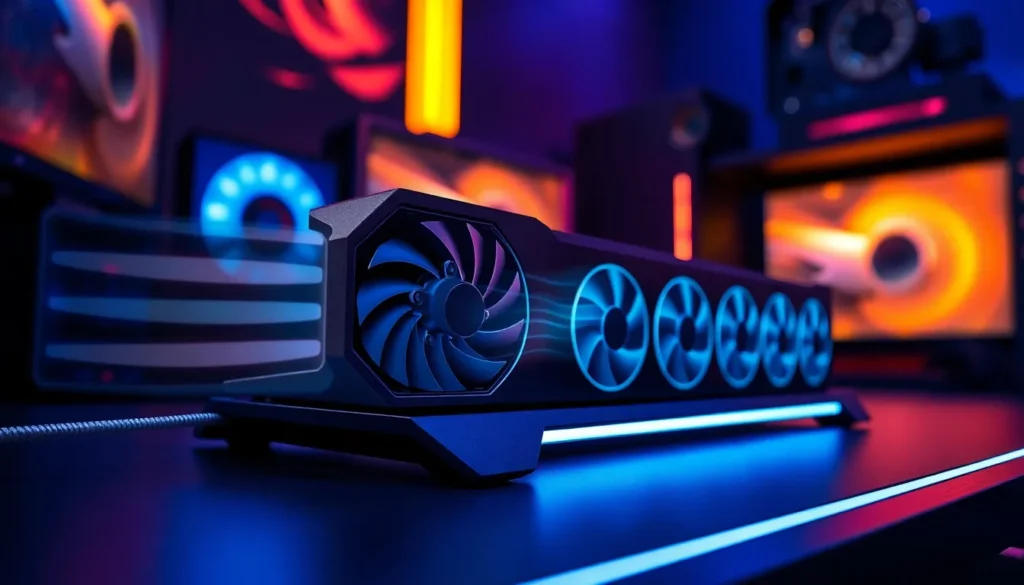When it comes to gaming on the go, the Steam Deck has become a beloved companion for many. But as players dive into intense gaming sessions, they might notice something whirring in the background—yep, that’s the fan. Understanding Steam Deck fan speed is crucial for maximizing performance and ensuring a smooth experience.
Imagine your fan is like a dedicated but slightly overzealous butler, eager to keep things cool. It can ramp up faster than a caffeinated squirrel when things heat up. Knowing how to manage that fan speed not only prolongs your device’s life but also keeps your gaming sessions blissfully quiet. So let’s explore the ins and outs of fan speed adjustments, and turn that whirring into a whisper.
Table of Contents
ToggleOverview of Steam Deck Fan Speed
Understanding Steam Deck fan speed plays a crucial role in optimizing gaming performance. The fan regulates temperature, ensuring internal components stay cool during extended play sessions. Overheating can lead to throttling, affecting game performance and user experience.
When demanding games are active, fan speed increases to manage heat effectively. Users may notice elevated noise levels in these instances. Some gamers prefer quieter environments, so managing fan speed enhances overall enjoyment.
Steam Deck offers various options for adjusting fan speed. Through the device’s settings, users can switch between automatic and manual controls. Automatic settings balance performance and noise efficiently, while manual adjustments allow for tailored control based on individual preferences.
Monitoring fan behavior also aids in identifying potential issues. An irregular or constantly high fan speed might indicate dust buildup or hardware strain. Regular maintenance ensures optimal airflow and device longevity.
Using third-party monitoring tools provides further insights into fan performance. Software like HWMonitor tracks temperatures and fan speeds, offering valuable data to gamers. This information can guide users in making informed adjustments, improving gaming conditions.
Ultimately, mastering Steam Deck fan speed creates a more satisfying gaming experience. Proactive adjustments contribute to better performance and quieter operation. Gamers can focus on enjoying their titles without distractions, achieving a perfect balance between power and noise.
Importance of Fan Speed

Fan speed plays a crucial role in maintaining optimal performance and longevity of the Steam Deck. Effective fan management ensures cooler internal temperatures, which protects sensitive components from overheating.
Cooling Efficiency
Cooling efficiency largely relies on the fan’s speed. Higher speeds provide greater airflow, reducing temperatures more effectively during intensive gaming sessions. A well-functioning fan prevents heat buildup that can lead to thermal throttling, allowing the device to sustain higher performance levels. Users notice that adequate cooling helps maintain stable frame rates, enhancing overall gameplay. Regular monitoring of fan performance aids users in early detection of any cooling issues, ensuring the Steam Deck runs smoothly over extended periods.
Performance Impact
Performance impact hinges significantly on fan speed adjustments. When users experience demanding gaming scenarios, increased fan speed can counteract potential overheating. In such instances, the device operates optimally, delivering smooth graphics and responsive gameplay. Manual fan control can also cater to personalized gaming preferences, striking a balance between noise and performance. Users achieve an overall better experience by managing fan speeds, especially during lengthy gaming sessions where consistent performance is vital. Recognizing the connection between cooling and performance encourages gamers to prioritize fan management for the best experience.
Factors Affecting Fan Speed
Understanding the factors that influence the Steam Deck’s fan speed is crucial for optimizing performance and maintaining a quiet gaming environment. Two primary elements affecting fan speed include ambient temperature and system load.
Ambient Temperature
Ambient temperature directly impacts internal cooling efficiency. Higher external temperatures can lead to increased fan speeds as the device works harder to cool its components. A cooler room environment allows the fan to operate at lower speeds, reducing noise levels. During summer months, users might notice the fan running more frequently to counteract elevated temperatures. Maintaining a temperature-controlled space benefits both hardware longevity and user comfort.
System Load
System load concerns the intensity of tasks being processed by the Steam Deck. During demanding gaming sessions, the CPU and GPU generate more heat, prompting the fan to increase its speed. Running resource-heavy applications or multiple programs simultaneously further elevates thermal output. Opting for less intensive settings can lower system load and allow for quieter fan operation. Users also benefit from monitoring performance while gaming, as understanding load dynamics aids in making informed adjustments for better cooling management.
User Adjustments and Customization
Steam Deck users can personalize their gaming experience by adjusting fan settings to suit their preferences. Customization can lead to quieter operation or enhanced cooling as needed.
Manual Controls
Manual controls in Steam Deck settings allow users to directly influence fan speed for their gaming sessions. Adjusting fan speed manually enables gamers to optimize airflow based on specific game demands. Users can set higher speeds during intense gameplay for maximum cooling efficiency, preventing overheating. This control empowers users to balance noise output and performance according to individual tastes. Simple adjustments can drastically impact the gaming experience, ensuring that performance remains stable even during taxing moments.
Third-Party Tools
Using third-party tools enhances the ability to monitor fan performance and temperatures. Software like HWMonitor provides real-time data on system temperature and fan speed, making it easier to analyze performance. These tools help users identify trends, detect issues, and make informed adjustments to fan settings. With detailed insights, gamers can modify their gaming environment or settings. Regular monitoring keeps the Steam Deck operating efficiently, prolonging its lifespan and ensuring optimal performance during gaming marathons.
Common Issues with Fan Speed
Users often experience noise disruptions during gaming sessions due to elevated fan speeds. Overheating of the Steam Deck occurs when internal components generate excessive heat, leading to intense fan activity. Dust buildup inside the device can also impede airflow, causing the fan to work harder for cooling.
Monitoring fan behavior provides insight into these problems. Factors like ambient temperature and system load significantly influence fan speed. Increased heat production during demanding games triggers higher speeds for effective cooling. Noticing irregular fan sounds may indicate underlying issues, such as hardware strain or an unexpected malfunction.
Automatic fan speed adjustments help maintain performance, yet some users might prefer manual control for specific gaming scenarios. Options exist within the settings to switch between automatic and manual controls. Finding the right balance between cooling efficiency and noise is crucial, especially in quieter environments.
Regular maintenance is essential for the Steam Deck. Cleaning the fan and vents prevents dust accumulation that can hinder performance. Additional monitoring tools, like HWMonitor, allow users to track temperature and fan speed trends over time. Tracking these metrics ensures proactive management of fan settings, enhancing the overall gaming experience.
Reducing system load can also contribute to quieter operation. Selecting lower graphical settings or closing background applications may decrease heat output and, subsequently, fan speed. Prioritizing effective fan management leads to better gameplay and a longer-lasting device, allowing for optimized performance during gaming marathons.
Understanding and managing the fan speed of the Steam Deck is crucial for an optimal gaming experience. By taking control of fan settings users can enhance performance while minimizing noise distractions. Regular monitoring and maintenance not only prolong the device’s lifespan but also ensure consistent gameplay without overheating issues.
Adjusting fan speed allows for tailored cooling solutions based on individual gaming demands. Whether opting for automatic settings or manual adjustments users can find the perfect balance between performance and quiet operation. Prioritizing fan management ultimately leads to a more enjoyable gaming experience, allowing gamers to fully immerse themselves in their favorite titles.






